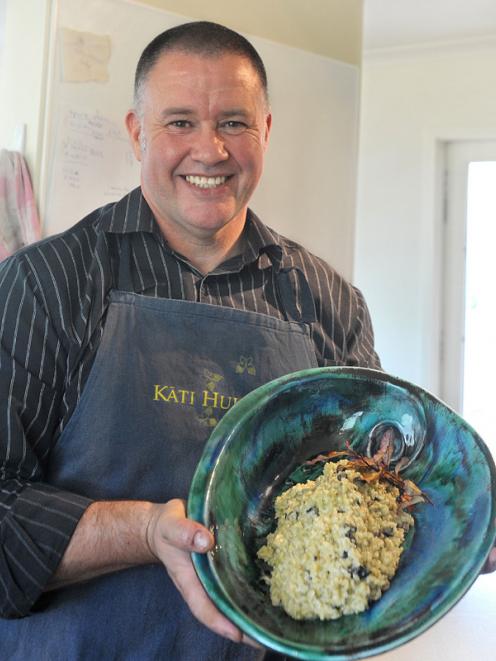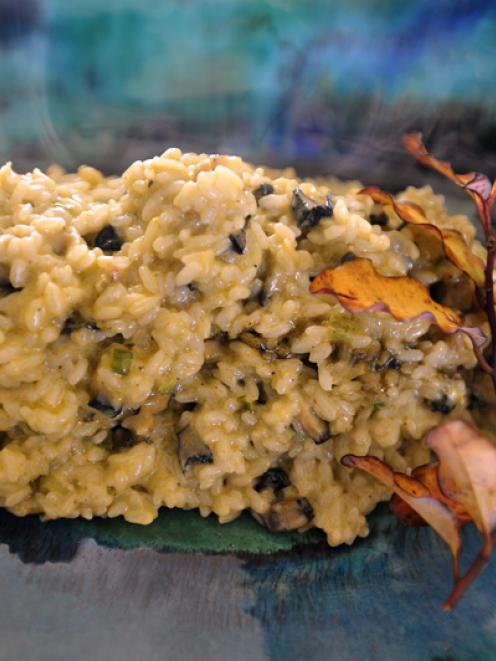Ron Bull shows how to make a shellfish risotto, with paua, New Zealand's favourite abalone.
Ron Bull is connected to local iwi Ngai Tahu, Kati Mamoe and Waitaha, and is interested in where food comes from, its associations, and how it connects people and communities.

Each season his family still harvests muttonbirds from the Titi Islands around Stewart Island. His ancestors used to trade preserved muttonbird with neighbouring peoples to the north for tuna (eel).
He is keen to celebrate everyday food, taking care with it, being in touch with it and sharing it.
Food keeps connections with people alive, he says.
Paua (abalone) is a traditional food and before European contact Maori used to smoke it by hanging on flax over a fire, to cook and preserve it.
For this dish he takes that idea and makes a creamy risotto with horopito, a herb and medicine from the native pepper tree leaves.
Smoked paua and horopito risotto

1 small paua, smoked
800ml chicken or vegetable stock infused with horopito
100g butter
½ onion, finely chopped
2 cloves garlic, finely chopped
1 stalk celery, finely chopped
250g risotto ricesalt to taste
To finish
50g butter, cubed
50g sour cream
50g finely grated parmesan cheese
Method
To shuck the paua, force your thumb between the flesh and the shell at the thin end of the shellfish, and under the foot to separate it from the shell. The gut should remain behind, but don't throw out the roe or stomach sac, which is rich and adds a good flavour.
Slice the paua flesh into strips. Put some manuka sawdust or chips in the bottom of a heavy pan and a rack over the sawdust. Put over high heat and when the wood starts to smoke, place the strips of paua and the roe on the rack. Cover and leave for about 15 minutes. When done, cut the paua into fine dice.
Heat the stock and add about a dozen whole fresh horopito leaves if you can find them or use powdered horopito. Allow to infuse.
Dice the onion, the garlic and the celery finely.
Put the stock in a pan to heat. Allow it to simmer, as you need to add it hot.
Melt the butter in a heavy pot and add the diced vegetables. Soften them gently, you don't want them to brown. When the vegetables have softened, add the diced paua and stir so the flavours mingle. When everything has softened, add the rice and stir so it, too, absorbs the butter and its flavours.
Turn the heat up a little and add a couple of ladlefuls of hot stock to the rice. It will bubble up. Stir gently and as it becomes absorbed, add another ladleful. Fold the rice over gently, taking care not to break it or to let it stick to the bottom of the pan. Continue until all the stock is absorbed and the rice grains are soft but still have a slight bite in the middle. If you run out of stock, use boiling water. The grains should no longer be translucent, but they should not be a gluggy mass either.
Turn off the heat and finish the risotto by adding the cubed butter and the sour cream, and grating the parmesan over finely. For extra flavour, add the chopped paua roe. Fold everything together. It should be thick and creamy with a beautiful green paua colour. Serve hot and share with friends.
Tips
• Horopito or pepper tree used to be a Maori medicine but it's now used as a culinary herb. It has a bite to it and too much can numb your mouth. Use whole leaves like bay leaves or buy powdered horopito in culinary stores.
• Short-grain rice is used for risotto. Arborio is usually the choice, but Ron says he buys sushi rice from an Asian store because it is cheaper and does the same job.
• You have to spend time with risotto, stirring from time to time and preventing it burning on the bottom. Maori like to spend time with the elements of their food and get to understand it. Risotto, which you have to stir gently as you add stock bit by bit, is good for that, he says.
• Paua roe has a strong flavour, like caviar or truffles, that many people love but a few find too strong.
• Ron collected the paua from Karitane and the horopito came from a local garden.
• Thanks to Afife Harris and Centre City New World.

